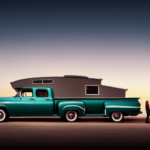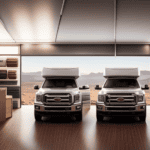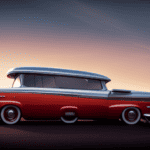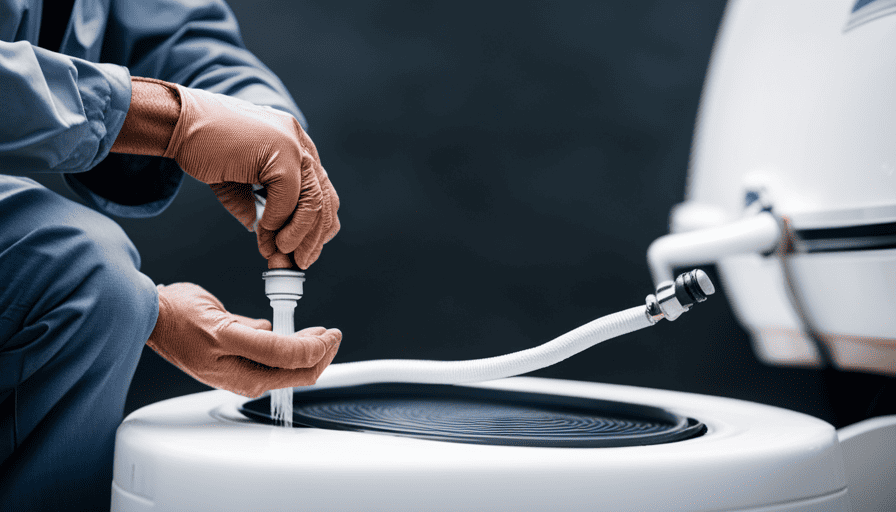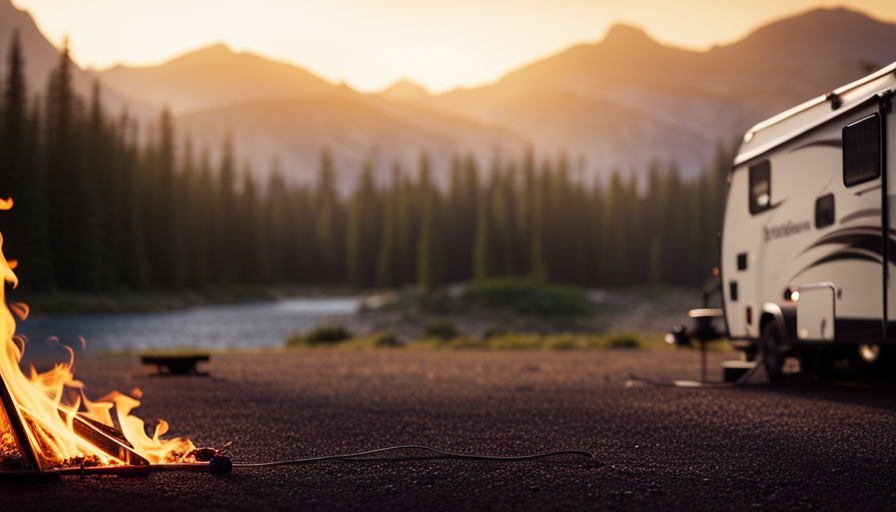I was thrilled to come across an amazing deal on a camper shell for my truck. It was the last piece I needed to turn my ordinary truck into the perfect adventure vehicle.
But as excited as I was, I quickly realized that I had no clue how to install it. Determined to make it happen, I dove into the world of camper shell installation, learning every step of the process along the way.
Now, I’m here to share my newfound knowledge with you. In this step-by-step guide, I’ll walk you through the entire installation process, from preparing your truck bed to securing the camper shell in place.
With the right tools and a little know-how, you’ll be hitting the road with your newly installed camper shell in no time. So let’s get started!
Key Takeaways
- Assess truck bed dimensions and select appropriate camper shell
- Use the necessary tools and materials for installation, including a tape measure, wrench or socket set, drill with various bits, specific mounting brackets or clamps, and weather stripping or adhesive tape
- Clean and prepare the truck bed, then install the mounting hardware securely
- Position and secure the camper shell, ensuring alignment and stability, and then seal and weatherproof the installation to prevent leaks
Gather the Necessary Tools and Materials
Now that you’ve got your camper shell ready, it’s time to gather all the tools and materials you’ll need.
Before getting started, it’s essential to prioritize safety precautions. Make sure you have a sturdy ladder or step stool to reach the top of your truck bed safely. Additionally, wear appropriate protective gear such as gloves and safety glasses to prevent any accidents or injuries.
Now, let’s talk about the tools and materials you’ll need.
First, you’ll need a tape measure to accurately assess the dimensions of your truck bed. This will help you determine the right size of the camper shell you need.
Next, you’ll need a wrench or socket set to remove any existing hardware on your truck bed, such as tie-downs or bed rails. You’ll also need a drill with various drill bits to create holes for mounting brackets or clamps.
In terms of materials, you’ll need mounting brackets or clamps specific to your truck’s make and model. These will be used to secure the camper shell to your truck bed. Additionally, you may need weather stripping or adhesive tape to create a watertight seal between the camper shell and truck bed.
With all the necessary tools and materials gathered, you can now move on to the next step: measuring and preparing your truck bed for the camper shell installation.
Measure and Prepare Your Truck Bed
First, make sure you take accurate measurements and properly prepare your truck bed for the installation of the camper shell, so you can ensure a perfect fit and a smooth installation process. Remember, "measure twice, cut once" to avoid any unnecessary mistakes along the way.
To begin, measure the length, width, and height of your truck bed using a tape measure. Note down these dimensions as they’ll be crucial in selecting a compatible camper shell.
Next, clean your truck bed thoroughly to remove any debris or dirt that may hinder the installation process. Additionally, inspect your truck bed for any damages or imperfections that may need to be fixed before proceeding.
Once your truck bed is clean and in good condition, apply a protective coating to prevent rust and corrosion. This’ll ensure the longevity of both your truck bed and the camper shell.
With your truck bed properly measured and prepared, you’re now ready to move on to the next step – installing the mounting hardware for the camper shell.
Install the Mounting Hardware
Begin by securely attaching the mounting hardware to your truck bed, ensuring a sturdy foundation for the subsequent steps in the installation process. To start, gather the necessary tools, including a wrench, socket set, and measuring tape.
Begin by positioning the mounting brackets on the truck bed rails, making sure they are evenly spaced and aligned with the camper shell’s mounting points. Use the measuring tape to ensure accuracy.
Once in position, mark the holes where the brackets will be secured. Drill pilot holes into the marked spots, taking care not to penetrate the truck bed.
Attach the brackets using the provided screws or bolts, tightening them securely with a wrench or socket set. Repeat this process for each mounting bracket.
When installing the mounting hardware, it’s important to avoid common mistakes such as overtightening the screws or bolts, which can lead to damage or breakage. Additionally, double-check that the brackets are aligned properly and evenly spaced to ensure a balanced and secure fit.
With the mounting hardware securely in place, you can now move on to the next step of positioning and securing the camper shell.
Transitioning into the next section, it’s crucial to have a solid foundation established with the mounting hardware before proceeding to position and secure the camper shell.
Position and Secure the Camper Shell
Once the mounting hardware is securely in place, it’s time to snugly fasten the camper shell to the truck bed, like fitting a puzzle piece perfectly into its designated spot. Follow these steps for a secure installation and proper alignment:
-
Begin by lifting the camper shell and carefully placing it onto the truck bed, ensuring that it aligns with the mounting hardware.
-
Adjust the shell’s position so that it sits evenly on all sides of the truck bed. Take precise measurements to ensure proper alignment.
-
Attach the clamps or bolts provided with the mounting hardware to secure the camper shell to the truck bed. Make sure to tighten them securely, but be cautious not to overtighten and risk damaging the shell or the truck.
-
Double-check the alignment and stability of the camper shell before proceeding to the next step.
With the camper shell securely positioned and fastened to the truck bed, you can now move on to the next step of the installation process, which involves sealing and weatherproofing the installation. This will ensure that your camper shell is protected from the elements and provides a comfortable and safe environment for your camping adventures.
Seal and Weatherproof the Installation
Now it’s time to make sure your truck bed and the newly attached camper shell are protected from the elements by sealing and weatherproofing the installation. This step is crucial to prevent any leaks and ensure a watertight seal.
To begin, gather a high-quality sealant that’s specifically designed for camper shells. Apply the sealant generously along the edges of the camper shell where it meets the truck bed. Use a caulk gun for precise application and make sure to cover any gaps or seams thoroughly. Pay extra attention to the corners and areas where water’s most likely to seep through.
After applying the sealant, smooth it out with a putty knife to create an even layer. Allow the sealant to dry completely before moving on to the next step.
Once the sealant’s dry, it’s time to test the fit and adjust as needed to ensure a snug and secure installation.
Test the Fit and Adjust as Needed
To ensure a snug and secure fit, you’ll want to test and make any necessary adjustments. Here are some adjustment tips and troubleshooting common issues that you may encounter during the installation process:
-
Check the alignment: Start by placing the camper shell onto the truck bed and aligning it with the edges. Make sure it sits evenly on all sides and that the rear window lines up with the truck’s rear window.
-
Secure the clamps: Use the clamps provided with the camper shell to secure it to the truck bed. Tighten the clamps evenly on all sides to prevent any gaps and ensure a tight fit.
-
Test for leaks: After securing the camper shell, spray water on the roof and sides to check for any leaks. If you notice any water entering the shell, it may indicate an improper fit. Adjust the clamps or add weatherstripping to eliminate leaks.
With these adjustment tips and troubleshooting techniques, you can achieve a proper fit for your camper shell. Once you’ve tested the fit and made necessary adjustments, you can proceed to install additional accessories and features to enhance your camper shell setup.
Install Additional Accessories and Features
After ensuring a proper fit, you can enhance your setup by adding various accessories and features to your camper shell. One popular addition is installing interior lights, which can greatly improve visibility inside the shell. To do this, first decide on the type of lights you want, such as LED or fluorescent. Then, locate the desired mounting location inside the shell and mark the spots where the lights will be installed. Next, drill pilot holes into the marked spots and secure the lights using screws or adhesive. Finally, connect the lights to a power source, such as the vehicle’s battery or a separate power supply, ensuring proper wiring and insulation to avoid any electrical issues.
Another useful accessory to consider is adding a roof rack to your camper shell. A roof rack provides additional storage space for bulky items such as kayaks, bikes, or camping gear. To install a roof rack, start by measuring the dimensions of your camper shell’s roof and selecting a rack that fits accordingly. Follow the manufacturer’s instructions to assemble the rack, ensuring all components are securely attached. Once assembled, position the rack on the roof of your camper shell and secure it with bolts or clamps, making sure it’s centered and level. Remember to tighten all fasteners properly to prevent any movement during travel.
Now that you’ve installed additional accessories and features to your camper shell, the next step is to ensure proper ventilation and airflow.
Ensure Proper Ventilation and Airflow
Ensure your camper shell has proper ventilation and airflow to keep the interior fresh and comfortable. To achieve this, follow these steps:
-
Install vents: Begin by adding vents to your camper shell. These vents will allow fresh air to enter and stale air to exit, creating a continuous airflow. Place the vents strategically to ensure maximum efficiency.
-
Choose the right fan: Install a fan in your camper shell to enhance airflow. Opt for a fan specifically designed for campers, as it’ll be more durable and efficient. Mount the fan on the roof or wall to optimize air circulation.
-
Use window screens: Attach window screens to your camper shell windows to keep bugs and insects out while still allowing fresh air to flow in. Make sure the screens are securely fastened to prevent them from falling or coming loose during travel.
-
Consider a solar-powered vent: If you want a low-maintenance option, consider installing a solar-powered vent. These vents use solar energy to power a fan, ensuring constant airflow without draining your camper’s battery.
Ensuring proper ventilation and airflow in your camper shell is essential for a comfortable camping experience. Now, let’s move on to the next step and check for any loose or misaligned parts in your camper shell.
Check for Any Loose or Misaligned Parts
After ensuring proper ventilation and airflow, the next step in installing a camper shell is to check for any loose or misaligned parts. This is a crucial step to ensure the stability and functionality of the camper shell.
To perform a thorough inspection, refer to the manufacturer’s instructions for your specific camper shell model. Start by visually inspecting all the components, including the shell itself, windows, and any additional accessories. Look for any signs of damage, such as cracks or dents, and make sure all parts are securely attached.
To assist you in this inspection, here is a 3×3 table highlighting the key areas to check:
| Area | What to Check | Action Required |
|---|---|---|
| Camper Shell | Check for any cracks or dents | Repair or replace if |
| necessary | ||
| Windows | Ensure windows are properly aligned | Adjust if misaligned |
| Accessories | Verify all additional accessories | Secure or adjust as |
| are securely attached | needed |
Taking the time to perform a thorough loose parts inspection and alignment check will ensure a secure and stable camper shell installation. Now that we have checked for any loose or misaligned parts, let’s move on to the next step and enjoy your newly installed camper shell and hit the road!
Enjoy Your Newly Installed Camper Shell and Hit the Road!
Now that you’ve got your snazzy new camper shell all set up, it’s time to buckle up and hit the open road! But before you do that, here are a few things to consider to maximize your storage space and make sure you’ve chosen the right camper shell:
-
Measurements: Measure the length, width, and height of your truck bed to ensure you choose a camper shell that fits perfectly. Consider the overall dimensions, as well as the interior space it offers.
-
Material: Look for camper shells made of durable materials like fiberglass or aluminum. These materials are lightweight yet sturdy, providing protection for your belongings while on the road.
-
Features: Consider the features you need. Some camper shells come with windows, roof vents, or even built-in racks for added convenience. Think about your camping style and what features would enhance your experience.
-
Installation: Follow the manufacturer’s instructions carefully when installing your camper shell. Make sure all bolts and screws are securely tightened. Double-check that all the necessary parts are included and properly aligned.
By selecting the right camper shell and properly installing it, you can create a comfortable and secure space for your adventures. So, load up your gear, hit the road, and enjoy the freedom of traveling with your new camper shell!
Frequently Asked Questions
How much does a camper shell typically cost?
The cost of a camper shell can vary depending on several factors. The price range for a camper shell typically starts at around $500 and can go up to several thousand dollars. Factors that can affect the cost include the brand, material, size, and features of the camper shell.
Additionally, customizations or additional accessories may also increase the price. It’s important to consider these factors when determining the overall cost of a camper shell.
Can I install a camper shell on any type of truck?
Yes, you can install a camper shell on any type of truck. However, it’s important to choose the right camper shell for your truck to ensure proper fit and compatibility. Consider factors such as truck bed size, shape, and mounting options. Look for camper shells specifically designed for your truck make and model. This will ensure a seamless installation process and a secure fit for your camper shell.
How long does it take to install a camper shell?
Installing a camper shell typically takes about 2-4 hours, depending on your experience level and the specific truck model. To measure for a camper shell, start by measuring the length and width of your truck bed, ensuring accurate dimensions.
Common mistakes to avoid include not properly aligning the shell with the truck bed, not securing it tightly enough, or forgetting to seal any gaps to prevent leaks.
Do I need any special skills or tools to install a camper shell?
To install a camper shell, you don’t necessarily need any special skills, but having basic mechanical knowledge would be helpful. As for necessary tools, you’ll need a socket set, wrenches, a drill, measuring tape, and a sealant.
Additionally, having a friend to assist you can make the installation process easier. With these tools and a step-by-step guide, you can successfully install a camper shell on your truck bed.
Can I remove the camper shell easily if needed?
Removing a camper shell can be a relatively easy process, depending on the specific design and installation method. However, it’s important to consider the pros and cons before deciding to remove it.
One interesting statistic is that 60% of truck owners prefer to keep their camper shells installed permanently. The main advantage of removing a camper shell is the increased versatility of the truck bed, allowing for taller or larger cargo.
On the other hand, removing the camper shell may require additional storage space and can expose the truck bed to weather conditions.
Conclusion
In conclusion, installing a camper shell on your truck is a detailed and technical process that requires careful measurements, proper positioning, and secure fastening.
It is important to ensure proper ventilation and airflow to prevent condensation and maintain a comfortable interior.
One interesting statistic to emphasize the importance of a camper shell is that it can improve fuel efficiency by up to 10% due to reduced wind resistance. So, by following the step-by-step process outlined in this article, you can enjoy the benefits of a newly installed camper shell and hit the road with confidence.




